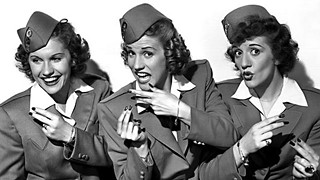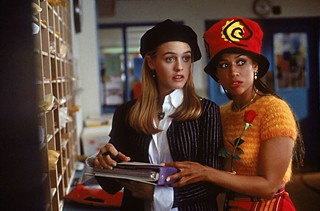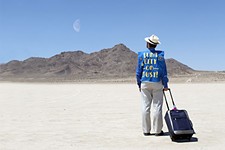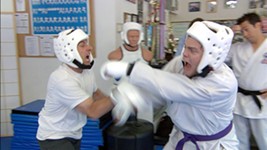The Second Fiddle Takes a Bow
Scene stealers at the Paramount Summer Classic Film Series
Fri., May 25, 2012
007's No. 2: Bond's Q
James Bond was never a rogue agent. He was just one razor-lined cog in British military intelligence organization MI6. Of course, the global supervillians had their henchmen, but most of them were dispatched before the jet-setting spy with a license to kill ever entered their secret volcano lair or tropical compound. After all, how could Odd Job's razor-rimmed bowler hat or Jaws' metal teeth defeat the quirky genius of Q, Bond's nutty professor?
There's a conspiracy theory that Bond is not a single man, but a nom de guerre adopted by a series of disposable killers. That could explain why he magically transforms from Scottish milkman Sean Connery into Australian model George Lazenby. But Q was always Q, and Q was always quirky, distracted, and tweed-clad Desmond Llewelyn. He was the definitive cinematic boffin, born of an era where scientists created bouncing bombs and spies were stabbed with poison umbrellas. For 36 years, across 17 films and five Bonds, Q and his band of anonymous engineers kept the world's most dangerous spy supplied with rocket-firing Aston Martins, exploding key chains, and scuba snorkels disguised as seagulls.
Llewelyn wasn't the first Q. Technically, that was Peter Burton in Dr. No, appearing as MI6 armorer Major Boothroyd. But the gizmos began with Llewelyn's brief cameo in 1963's From Russia With Love; a year later in Goldfinger, he finally took Bond into the bowels of his Q-Branch laboratory, and that was where the true Q was born. He was part of a grand British tradition of tinkerers and potterers, men of an engineering mind who would play with gadgets and gizmos in their shed: Like Heath Robinson (the UK's analogue to Rube Goldberg), but with more smoke grenades. But Llewelyn made Q more than just a mad professor. He was Bond's kindly uncle, slipping the overgrown schoolboy treats and toys for his adventures, and boxing him around the ears when he broke them. He was the only man allowed to best Bond in a battle of quips, and the only man to make sure he came back alive. – Richard Whittaker
On Her Majesty's Secret Service screens Thursday, July 5, 7pm; Friday, July 6, 9:15pm.
Goldfinger screens Thursday, July 5, 9:45pm; Friday, July 6, 7pm.
The Spy Who Loved Me screens Saturday, July 7, 2pm, 7:05pm; Sunday, July 8, 4:35pm.
The Living Daylights screens Saturday July 7, 4:30pm; Sunday, July 8, 2pm, 7:10pm.
Delta Dame: 'Cat on a Hot Tin Roof'
That impossibly high forehead, those Daisy Duck eyes, that Dixie caterwaul – nobody, not even Tennessee Williams himself, seems more Tennessee Williams than Madeleine Sherwood. Always a foil for the pretty and good, Sherwood takes "grotesque" to the stratosphere, to the sublime. See her as the protuberantly pregnant villain in Richard Brooks' Cat on a Hot Tin Roof, as the chintzy, lazy politician's mistress in Brooks' Sweet Bird of Youth, and again – even in a movie that has nothing to do with Tennessee Williams! – as the Muppet-y bigot in Sunday dress in Otto Preminger's Hurry Sundown.
Mae, her character in Cat on a Hot Tin Roof, reprised from her role in the Broadway play directed by Elia Kazan, is a Southern Gothic archetype. She is the eavesdropping church lady, perverse in a uniquely Protestant way, with a nose for sniffing out nonconformism in other people's children and a womb that just won't quit. While Elizabeth Taylor enjoys three wardrobe changes, Sherwood remains in her hideous maternity dress, waving a Confederate flag and conducting a jamboree of "no-neck monsters" (her offspring) in a sing-along. As a Williams creation we both loathe and understand her completely. We can't take our eyes off her.
Theater scholar Nancy M. Tischler suggests Mae is both an autobiographical reflection of Tennessee Williams' mother and a caricature of a contemporary adversary for the artist as well, "the kind of middle-aged, middle-class matinee patron he was expected to satisfy with his plays."
However, the real Madeleine Sherwood (still around, but retired from acting) is just the opposite. Blacklisted in Hollywood, she was active in the Civil Rights movement and Women's Lib. Most shocking of all? She's from Canada. – Leah Churner
Sunday, June 3, 5pm.
The Poet-Pioneer: 'The Man Who Shot Liberty Valance'
The Man Who Shot Liberty Valance is a master-class in mid-20th century American movie acting. From Jimmy Stewart's inner turmoil to John Wayne's conflicted decency, to Lee Marvin's unhinged cruelty, the movie offers three of old Hollywood's greatest stars doing what they do best. But the star of the show is Edmond O'Brien as Dutton Peabody, the publisher, editor, and star reporter of The Shinbone Star – the eloquent pioneer drunk with Shakespeare on his lips and booze in his beard. For us, O'Brien's cackling, wheezing laugh was as much a part of the Western movie aesthetic as the shotgun, and his faux-English affectations set against the roughness of the terrain were the perfect demonstration of director John Ford's lifelong fascination with the struggle between civilization and freedom in the American West.
Liberty Valance may be about an attorney from the east trying to bring law to the lawless frontier, but O'Brien's small-town newspaperman was there long before Jimmy Stewart's Ransom Stoddard, preparing his way like a southwestern John the Baptist, bringing a touch of class and verbal sophistication to an otherwise coarse country. His murder isn't just an act of personal brutality; it's an attack on progress, and O'Brien plays the scene first with theatrical defiance and then unbelieving terror. While he's alive, though, Peabody is all the way alive: His eyes leer and roll like Groucho Marx's and his voice is filled with vaudevill-ian outlandishness, like he's always on the verge of breaking into some elaborate song-and-dance routine. O'Brien would raise the knee-slapping, bearded old codger character to new heights of rococo brilliance seven years later in Sam Peckinpah's The Wild Bunch, but it was Liberty Valance that established him as one of the great character actors of his, or any other, era.
– Josh Rosenblatt
Thursday, June 14, 9:30pm; Friday, June 15, 7pm.
Mommy Monster: 'The Manchurian Candidate'
Richard Condon's frosty slice of Cold War paranoia boasted a real nightmare of a premise: All-American war hero gets reprogrammed into a Communist sleeper agent whose assignment is assassinating a presidential candidate. But in the 1959 novel's translation to the silver screen, the most frightening thing is Angela Lansbury's Eleanor Shaw Iselin, mother to the brainwashed soldier and – brrr! – his undercover Commie handler, the one who will trigger his murderous mission. Frank Sinatra had the star power (indeed, he was instrumental in getting the picture made); Laurence Harvey had the star turn (in the showy, sweaty role of the conflicted veteran-slash-ticking time bomb), and Leigh had the star sizzle (riding high on the terror-ific success of Psycho), but whenever Lansbury hit the screen, everyone else receded into the background.
Her Iselin – accent on that first syllable – was so cold, the temperature dropped 30 degrees whenever she entered a room. Her immaculately coiffed, immovable, upswept 'do was like the tip of an iceberg, beneath which swirled the deep, dark thoughts of a manipulative mind Machiavelli would have recoiled from. Though just 36-years-old to Harvey's 33, Lansbury was not only credible as his mother, but as a mother so controlling and ruthless, she'd willingly sacrifice her own son for political power. The actress wasn't favored with a Best Supporting Actress Oscar (she was beaten out by young Patty Duke playing Helen Keller in The Miracle Worker) but 50 years after the film's release, Lansbury's performance still compels – and repels. You can't tear your gaze from those dead eyes, that eerie detachment. And the serrated edge in her voice draws blood every time she speaks. Just listening to her steely commands to poor Henry Silva about preparing dinner make my hands go clammy and cold sweat bead on my brow. Watching her kiss her trance-triggered son full on the mouth before sending him off to blow someone's brains out? It makes my flesh crawl – and seals The Manchurian Candidate as a film that Angela Lansbury owns. – Robert Faires
Thursday, June 14, 7pm; Friday, June 15, 9:30pm.
That Boogie Style: 'Buck Privates'
Despite the multiple wars and "regional conflicts" America, Inc. currently finds itself embroiled in, we are sorely lacking in a contemporary equivalent to the Andrews Sisters. The modern USO has tossed everyone from Britney Spears to Kid Rock into the mix – and come up wanting; no one can capture the essence of red, white, and blue musical-patriotism like the Andrews Sisters. No wonder we're neck deep in military quagmires: We are a nation bereft of any musical performers remotely in the same all-smiling, all-jump-swinging, all-dancing-dames vein as LaVerne, Maxene, and Patty. Buck Privates was the harmonizing sibling trio's first feature film, and they steal it away from nominal comedy duo Bud Abbott and Lou Costello at every opportunity. Made just one year prior to America's entry into World War II, the film itself is a pleasant peacetime goof, with lantern-jawed character actor Nat Pendleton (The Thin Man) pulling rank on pudgy laffster Lou and slick con-artist Bud as they blunder their way through what would all too soon be the end of peacetime basic training. For sheer entertainment value, though, this is the Sisters' gig all the way. The jitterbug bounce of showstopping World War II supersong "Boogie Woogie Bugle Boy (of Company B)" is as irresistible today as it was then, and "(I'll Be With You) In Apple Blossom Time" cuts both the rug and the heart. – Marc Savlov
Tuesday, July 17, 7pm; Wednesday, July 18, 8:45pm.
In Praise of Pazuzu: 'The Exorcist'
The Exorcist was the first scary movie I ever saw. I watched it while sleeping over at a friend's house. My parents wouldn't let me see horror films, and after watching The Exorcist I found out why – two sleepless nights later. My father and I would eventually bond over this particular film; nothing beats two men (my father's Methodist, I'm Jewish) making signs of the cross at each other, and yelling "The power of Christ compels you!" Sure, Ellen Burstyn and Linda Blair (who won a Golden Globe for Best Supporting Actress for her portrayal of Regan MacNeil) make star turns, but we all know who – or rather what – we watch the exorcist for: Pazuzu, the demon possessing poor, poor Regan.
Although called "Captain Howdy" early in the film, Pazuzu is explicitly named as the possessing demon in the original book and sequel films. Watch the first scene of The Exorcist carefully, and you'll see Father Lankester Merrin (Max von Sydow) pull out a statue of Pazuzu – the Assyrian god of the southwest winds who brings famine and locusts – from an archeological site in Iraq. He's a scary figure to be sure, with dragonfly-like wings, a scorpion's tail, the head of a dog, and a big serpentlike schlong. Pea soup vomit, head spinning, psychological torture, and disturbing (mis)use of the crucifix all seem to be the particular purview of Pazuzu, making him one of the most gruesome and memorable baddies in cinema history. For that, and much more, we can't take our eyes off of him. Go to see some of William Friedkin's finest directing work (I'm still waiting for the summer that Cruising is programmed into the Paramount series), but stay for Pazuzu's litany of bad intentions.
A postscript: A couple of years ago, in a museum in New York City, I saw an oversized version of the Pazuzu statue made by artist Roberto Cuoghi. It awakened something chthonic in me – distressing to my very core. The cause of my nausea was only pinpointed weeks later while re-watching The Exorcist. Pazuzu works in mysterious ways. – Andy Campbell
Saturday, July 28, 3:35pm; Sunday, July 29, 2pm, 6:05pm.
Madame's Method: 'Dance, Girl, Dance'
In the movies, she'll always be best remembered as Maleva, the Gypsy fortune-teller in two of Universal's great horror films from the Forties, The Wolf Man and Frankenstein Meets the Wolf Man. If Hollywood needed an old crone with a European accent, they called on Maria Ouspenskaya. Yet the Russian émigré and acting legend was capable of so much more. Having trained in her youth with the inventor of Method acting, Constantin Stanislavski, she spread its gospel in the States – decades before actors like Marlon Brando and James Dean made the technique popular in the Fifties. Ouspenskaya played kindly grandmothers, ballet teachers, an Amazon queen, and was nominated for a Best Supporting Actress award in her debut American film, Dodsworth. She worked in A-pictures and B-movies, billed herself as Madame Maria Ouspenskaya, governed her life by her horoscope, and died in 1949 due to consequences caused by falling asleep while smoking. It is also she who, with her dying breath as the inspirational ballet teacher, Madame Lydia Basilova, in Dance, Girl, Dance, exhorts Maureen O'Hara's chorus girl, Judy, to "dance, dance, dance."
Those instructions are not as easy as they may sound. Judy's balletic ambitions are subsidized by kicking her heels as a nightclub chorine, performing for drunks and louts with her friend Bubbles – who is played by Lucille Ball, still a decade away from television comedy fame. Bubbles is much more comfortable shaking her booty in public and harbors no fantasies of achieving high art success. But each woman supports the other's goals and pools her talents for the greater good of the dance company – just as Madame Basilova had done. It doesn't take much to extrapolate their dilemma to the eternal predicament faced by women in the entertainment business (choosing between peddling flesh and peddling art) or the state of Hollywood movies then, and now – electing to pursue individual visions, or just giving the people more of what they seem to want. "Dance, dance, dance," implores Maria Ouspenskaya from the grave. – Marjorie Baumgarten
Tuesday, June 5, 8:40pm; Wednesday, June 6, 7pm.
Cheater's Choice: 'The Sting'
"You know what they say about these waters? If the Jamaican pirates don't getchya, it'll be the cold embrace of the sea. And that's no lover's kiss." Such was my early-Eighties high school yearbook quote, and while I still glean no great meaning from The Deep pronouncement, in 1977 it sounded like high seas adventure to a suburban 12 year old. In fact, you couldn't go near the water in the Seventies without Robert Shaw splashing in behind you. Chicago's Depression-era waterfront in 1973 smash The Sting pools a far cry from the Caribbean locales of treasure seeker The Deep, but as gangster Doyle Lonnegan – gunning for Newman and Redford in this spiritual sequel to Butch Cassidy and the Sundance Kid – Shaw's thespian bluster threads the two films. English, Shakespearean, receiving mentorship from knights-to-be John Gielgud and Alec Guinness, Shaw comes up consistent with the unforgettable gravitas he imbues into his cinematic immortality: shark hunter Quint in Jaws. Four novels and nine children to his credit, Shaw's slew of memorable screen performances begins with early indelible From Russia With Love, in which his killer Ruskie pounds James Bond like a precursor to Rutger Hauer in Blade Runner, and includes an Academy Award nod for his Henry VIII in A Man for All Seasons. The Sting, (nominated for 10 Oscars and winner of seven including Best Picture), dominoed his career into more commercial fare including The Taking of Pelham One Two Three, first $100 million grosser Jaws, Robin and Marian, and Black Sunday. He died of a heart attack in 1978 at 51. And that's no lover's kiss. – Raoul Hernandez
Saturday, May 26, 7:25pm; Sunday, May 27, 4:35pm.
The Bliss of Ignorance: 'Clueless'
We're all tired of hearing about how Amy Heckerling's Clueless is a Nineties update of Jane Austen's Emma. So I'd like to propose an alternative comparison from the chronological midpoint, Anita Loos' 1925 novel Gentlemen Prefer Blondes. Smart and savvy oddballs in their own right, Loos and Heckerling use the ingenious device of warped first person narration to pull off the irresistible coup of having it both ways: satirizing, while marshaling our affections for, the alpha-woman who always wins. Blessed with charm, beauty, and a male-pattern shamelessness, Cher and Dionne, like Gentlemen's Lorelei Lee and Dorothy, are incorrigible materialists but wiser philosophers than they seem.
Cher (Alicia Silverstone) is in the Lorelei role, always offering a dubious moral justification for her actions, while Dionne (Stacey Dash) is a modern Dorothy, direct, cynical and sarcastic. It is Dionne, more than Cher, who every girl in America wanted to be friends with – not because she's "mean," but because she has all the answers. Dash, who was 28 when she played this role, is an underrated comedienne. Her scenes with boyfriend Murray (Donald Faison) could have fueled a spin-off movie (both actors reprised their roles in the TV spin-off, which ran for three seasons).
As with Howard Hawks' 1953 adaptation of Gentlemen Prefer Blondes, Clueless is a visual feast of spangles, baubles and contrasting color schemes. Like Hawks, Heckerling has a knack for physical comedy, particularly when it comes to the hazards of transportation on land and sea; Stacey Dash's trauma during the freeway scene is hilariously tantamount to the nonchalance of Marilyn Monroe (playing Lorelei) at being stuck in a porthole.
Even after 17 years, the film is still fresh – and funnier than ever. I'm hipper to Heckerling's impeccable one-liners ("As soon as I get my license I fully intend to brake for animals") but now I'd like to take off my critic hat and inject a personal note, because my revisitation of Clueless came with a side of rampant, melancholic nostalgia.
At the film's release in July of 1995, I was 12 and a half and in the middle of a ternary rite of passage – that summer, I discovered shopping, switched to Diet Dr. Pepper, and got my period, in that order. I was apprehensive about starting 7th grade at a new school in the fall, and Clueless affirmed my faith in the feasibility of self-reinvention.
I was so enthralled by that theme, it occurs to me now, that I missed the major lesson of Heckerling's screenplay – that undergoing a makeover is the fun part. But the results seem paltry once you're on the other side, because you can't escape being you. Well, I would have said "Whatever!" to that. I didn't feel the least bit schizophrenic claiming Radiohead's "Fake Plastic Trees" as my favorite song while trolling Judy's and Contempo for a pleather mini-backpack and faux-furry poof pens. Life sans irony! Ah, cluelessness was bliss. – Leah Churner
Clueless screens Saturday, June 9, 12:30pm (Stateside), 12mid; Sunday, June 10, 4:20pm (Paramount). A scavenger hunt accompanies the Saturday noon showing, and Amy Heckerling will be in attendance at the Sunday evening show.
Welcome To Your Future: 'The Breakfast Club'
"You mess with the bull, young man, and you get the horns!" It is the pissed-off vice-principal Vernon people often quote from The Breakfast Club, that perfectly freeze-framed slice of 1985 youth. That movie couldn't be made today – not without cell phones and texting in place of the soul-affirming bonding the five misfits did through conversation and class conflict. Yet if it made stars of its young cast who became known as the Brat Pack (including Emilio Estevez as "the jock," Andrew, and Judd Nelson as "the criminal," Bender), writer and director John Hughes never neglected the side characters. Carl the Janitor (John Kapelos) is seen at the film's beginning in a graduation photo with honors, but doesn't appear until casually introduced. And he's the school janitor – no one for five kids with attitude to pay attention to until he busts them on their blind innocence.
"You guys think I'm just some untouchable peasant, a peon. Maybe so. But following a broom around after shitheads like you, I've learnt a couple of things. I look through your letters, I look through your lockers. I listen to your conversations. I do. I am the eyes and ears of this institution, my friends. By the way, that clock's 20 minutes fast."
They don't want to hear this, but he's their future. Furthermore, as the Club uncomfortably understands, he's right. He does know much more about them than they realize and it's their first inkling of the challenges that lie ahead out of high school: no guarantees on the job market. Yet Carl is more like them than they know. Vernon asks what Carl wanted to be when he grew up. Carl replies, "I wanted to be John Lennon," totally pissing off Vernon – who calls him a goof. Not a one of them seems aware that the janitor was once voted Most Likely To Succeed. Kapelos (who also starred in Hughes' Sixteen Candles) gave Carl a sweetness and wisdom, a kind of Jiminy Cricket to their Pinocchion misadventures. And Bender will be lucky to have that janitor job when he's 50. – Margaret Moser
Saturday, Sept. 1, 2pm, 6:05pm; Sunday, Sept. 2, 4:05pm.
The Keys to Chaos: 'Raising Arizona'
The Coen Brothers are rightly celebrated for creating some of the greatest protagonists in movie history – Barton Fink, Marge Gunderson, Jeffrey "The Dude" Lebowski, to name a few – but if you want to talk about the characters that truly define the pair's aesthetic, look to their supporting casts. Over 30 years and nearly 20 movies, Joel and Ethan Coen have left it in the hands of brilliant character actors to pull off the kind of repetitive verbal absurdity the brothers have built their name on. Think Richard Jenkins as alcoholic Walter Abundas moaning about "probity" in his rocking chair in The Man Who Wasn't There, Jim True-Frost as the manic elevator operator-turned-idea man Buzz in The Hudsucker Proxy, and Steve Buscemi as the oddly endearing bellhop Chet – "Chet!" – in Barton Fink. These are static creations, purely cinematic and unreal, sent out into the Coens' world to speak certain phrases or give certain looks or laugh certain laughs designed to remind viewers that they're watching a movie, with its own rules and logic, and to surround their leading men and women with a constant sense of surreal menace, or at least discomfort.
Two of the Coen Brothers' best creations were among their first: Glen and Dot, the loudmouthed parents of a pack of feral children sent to torment the heroes of Raising Arizona, H.I. and Ed McDunnough. Played with comic abandon by Sam McMurray and Frances McDormand, Glen and Dot are the embodiment of the lousy American couple – narcissistic, racist, tone-deaf, blind to their own faults yet keenly and vocally aware of the faults of others, dying to have babies but indifferent to raising the ones they already have – and their brief visit to the McDunnoughs' trailer home is a comic masterpiece of chaos and self-absorption. While Dot fawns garishly over Ed's new baby ("Oh! He's an angel! He's an angel straight from heaven!"), Glen casually informs H.I. that "something went wrong" with his semen while ignoring the fact that his five children are destroying their hosts' home. With their joyously outsized approach to their characters, McDormand and McMurray both set the blueprint for all the bizarre and memorable Coen supporting players to follow. – Josh Rosenblatt
Tuesday, June 12, 9:15pm; Wednesday, June 13, 7pm.














